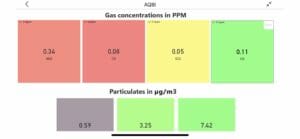
It is widely recognised that poor air quality and high levels of particulates can significantly impact an individual’s health. The WHO estimates that 7 million people die each year from exposure to fine particles in polluted air. A recent study published in the New England Journal of Medicine has confirmed the association between short-term exposure to particulates and increased cardiovascular and respiratory mortality. The significant health risk posed by pollution is a crucial driver behind IoT air quality monitoring, electric vehicles and renewables.
What is Particulate Matter?

Particulate matter is of particular concern to public health because of its toxicity and association with cardiovascular and respiratory disease. PM describes inhalable particles with a diameter of less than 10μm (known as PM10) and super-fine particles with a diameter of less than 2.5μm (known as PM2.5). There is a strong association between PM and health risks, the WHO and many other bodies define safe limits and enforce air quality guidelines.
- PM10 includes inhalable particles such as dust, mould, pollen, etc.
- PM2.5 includes fine particles that can be inhaled, including combustion particles, organic compounds, metals.
- PM1 would include dust, combustion particles, bacteria and viruses.
PM can be the result of pollutants from industry, motor vehicles and fossil fuels. Dust and other matter can be emitted by construction sites, dusty roads, chimneys and fires.
How is it dangerous?
Particulates often contain microscopic matter, including solids and liquids that, once inhaled, can lead to serious health problems. Particles that are less than 10μm can make it into your lungs and even your bloodstream! It is PM2.5 (2.5μm) particles that pose the most significant health risk.
How big is a μm?
A human hair is approximately 70μm – making it 30x larger than the largest fine particle and roughly 7x larger than PM10. 2.5μm is small – which is why it can be inhaled and make into your lungs.
How can PM be measured?

There are times when you can see a ‘haze’ in a city or rural setting – often, that’s due to fine particles. Internet of Things (IoT) technology enables fast and efficient measurement of particulates in the air with IoT sensors.
Outdoor particulate monitoring
Solutions such as the Libelium Plug&Sense Smart Environment can measure particle matter (1μm, 2.5μm and 10μm) and a range of gases associated with health risks. The Plug&Sense units can be installed on lampposts, buildings and vehicles – and transmit their measurements back to the cloud. You can then use the data to produce reports, dashboards and visualisations.
Indoor particulate monitoring
The Milesight AM300 series devices can measure PM2.5, PM10 and CO2 levels – making it the perfect instrument for assessing indoor air quality (IAQ). MTG have complete solutions for indoor air quality monitoring – you can learn more about these here.
Research: The health risks of particulate exposure
The study published by NEJM evaluated the association of particulate matter, specifically PM2 and PM10, with daily all-cause, cardiovascular, and respiratory mortality across multiple countries and regions. The study found independent associations between short-term exposure and increased mortality rates associated with cardiovascular and respiratory conditions.
Results

On average, an increase of 10 μg per cubic meter in the 2-day moving average of PM10 concentration, which represents the average over the current and previous day, was associated with increases of:
- 0.44% (95% CI, 0.39 to 0.50) in daily all-cause mortality
- 0.36% (95% CI, 0.30 to 0.43) in daily cardiovascular mortality
- 0.47% (95% CI, 0.35 to 0.58) in daily respiratory mortality.
CI = Confidence Interval
The researchers identified that the associations were more substantial with a lower annual mean PM concentration and higher mean temperatures.
Policy Making

The evidence linking poor air quality, particulates and air pollution to adverse health effects have been known for some time, but the body of evidence is building. As the population becomes more tuned into climate change, the environment and health – there is a growing need for Governments, schools and local authorities to take action. To do so – these organisations must collect reliable data on which they can base a strategy.
Sustainable population growth, transport strategies, urban & rural development and population health, must incorporate air quality as a critical consideration. Governments must pay close attention to:
- Indoor air quality. Monitoring the indoor environment of schools, colleges, and the workplace is becoming increasingly popular.
- Housing developments. Private and social housing developments built next to main roads or industrial sites are prone to polluted air. Residents opening windows and without any filtration system exposes residents to polluted air.
- Cycle routes and active travel. Active travel has many health benefits, but policymakers can pay attention to pollution hotspots when planning cycle or walking routes.
Find out more

Please get in touch if you would like to learn how Manx Technology Group can assist with the measurement and collation of air quality data (including particles). We are experts with IoT technologies that enable the rapid and inexpensive collection of air quality data that you can use to shape policy, inform and improve outcomes.
We can provide IoT air quality and particulate monitoring for mobile and fixed installations. These solutions offer a quick way of obtaining data and measuring poor air quality.
Contact our solutions team by e-mailing sales@mtg.im, call +44 1624 777837 or submit our request a quote form on the right-hand side.

